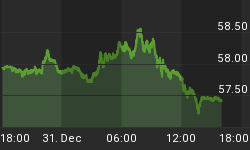It's curious, isn't it? So-called "paper gold" (a futures contract) has a price that is not only very close to physical gold, but it remains locked to it. This is despite the fact that "paper gold" is reviled in the gold community.
I am writing this on Sunday evening with little liquidity in the market, and yet spot gold (XAU) is 1665.80 and the December future (GC Z3) is 1674.40. There is a small positive spread, about 0.5%, between spot and future. This spread is remarkably consistent from day to day. If spot gold goes down 1.2% then the December future,and the other months as well, go down by almost exactly 1.2%.
It's worth underscoring that these are different prices for different things in different markets. "Paper gold" is not physical metal! If there weren't some force that kept their prices locked together, they would detach and one could rise while the other falls, or vice versa. This is not, in fact, how they behave. They remain locked (at least for the time being). Why? What is this mysterious force that binds them tightly together?
Let's take a step back for a moment. The futures market exists to serve the needs of producers and consumers. Producers -- miners in this case -- need to have predictable and consistent cash flow so they sell some of their production forward. Consumers, such as electronics manufacturers, and jewelers, have the same need so they buy some of their raw materials forward. Both can sign a contract now that locks in a price at some date in the future.
Of course, in the gold standard, there would be no such thing as a gold futures market. Futures for all other goods would be priced in terms of gold. Gold itself would not be available at a discount, nor would one ever need to pay a premium to get it. One could borrow it at interest, but that is in the bond market not in the futures market.
Once a futures market is established, speculators come in to bet on the direction of the price. They do not produce the good -- gold in this case -- nor use it. They cannot deliver gold to a buyer, nor do they wish to be delivered gold. They want to profit from a change in the price. They believe they have superior knowledge compared to the other market participants, and so use the futures market as an easier and more convenient way to bet than the physical metal market. And besides, the futures market offers leverage.
This is the basic theory of the futures markets, in a nutshell. Producers and consumers are trying to reduce risk. Speculators are making bets, pushing prices around, sometimes annoying the producers and sometimes annoying the consumers.
We still have not explained the fact that the price of "paper gold" tracks the price of gold metal. To do that, we need to introduce a third type of actor in the futures markets. The arbitrageur does not care about price; he is focused on spread. The arbitrageur can buy physical metal and at the same time sell a futures contract. This will earn him a little over $8 per ounce based on the prices I quoted at the top, or a bit more than 0.5% annualized. Compared to the yield on a 1-year Treasury, about 0.15%, this isn't bad.
So long as the price of the futures contract is higher than the price of the physical metal, then the arbitrageur can buy metal and sell a contract to pocket this spread. This will obviously lift the price of the metal and depress the price of the paper, compressing the spread. The arbitrageur will stop when the spread becomes too small to be worth his time, effort, and risk.
If the futures contract ever became cheaper than the physical metal (called "backwardation") then anyone who owns a gold bar can sell it and simultaneously buy a future with the intent to stand for delivery. In this case, the arbitrageur sells physical metal and buys a future, thus depressing the price of metal and lifting the price of the future. As in the previous case, the spread is compressed.
This is not merely academic theory. Analysis of this spread (called the "basis") can shed light on what's really happening in the markets. Sometimes (as now) there is a simple trade that is obvious, but only to someone looking at this spread.
In Part II of this article (free enrollment required for full access), we walk through the analysis and propose a contrarian precious metals trade.
















